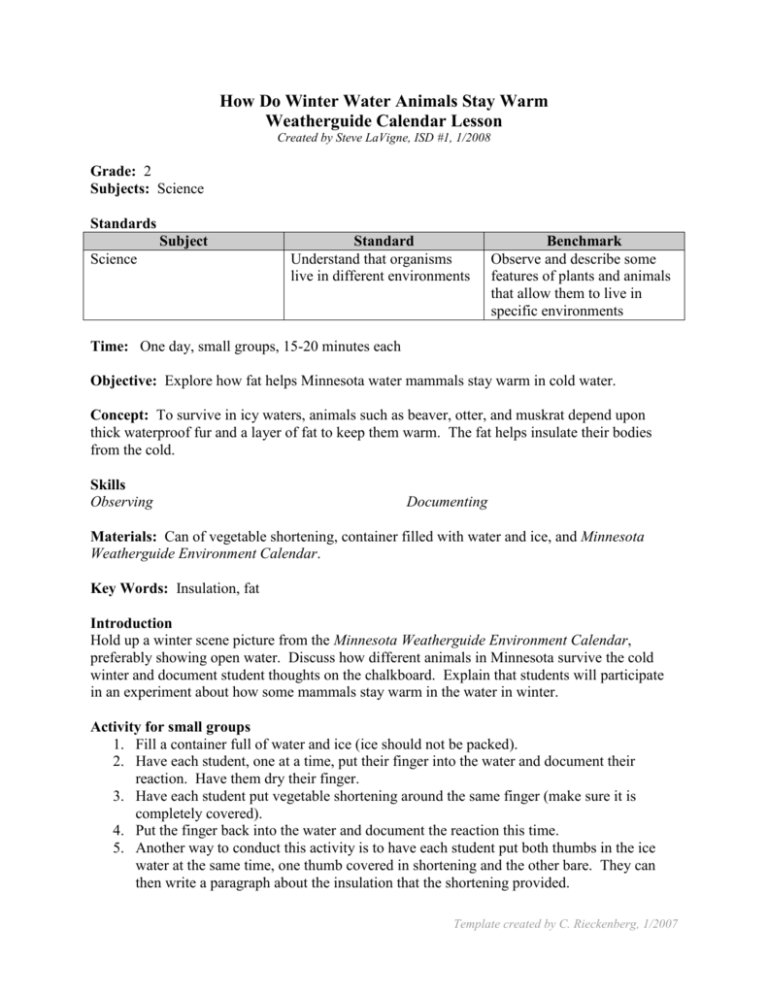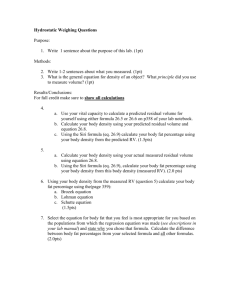How Do Winter Water Animals Stay
advertisement

How Do Winter Water Animals Stay Warm Weatherguide Calendar Lesson Created by Steve LaVigne, ISD #1, 1/2008 Grade: 2 Subjects: Science Standards Subject Science Standard Understand that organisms live in different environments Benchmark Observe and describe some features of plants and animals that allow them to live in specific environments Time: One day, small groups, 15-20 minutes each Objective: Explore how fat helps Minnesota water mammals stay warm in cold water. Concept: To survive in icy waters, animals such as beaver, otter, and muskrat depend upon thick waterproof fur and a layer of fat to keep them warm. The fat helps insulate their bodies from the cold. Skills Observing Documenting Materials: Can of vegetable shortening, container filled with water and ice, and Minnesota Weatherguide Environment Calendar. Key Words: Insulation, fat Introduction Hold up a winter scene picture from the Minnesota Weatherguide Environment Calendar, preferably showing open water. Discuss how different animals in Minnesota survive the cold winter and document student thoughts on the chalkboard. Explain that students will participate in an experiment about how some mammals stay warm in the water in winter. Activity for small groups 1. Fill a container full of water and ice (ice should not be packed). 2. Have each student, one at a time, put their finger into the water and document their reaction. Have them dry their finger. 3. Have each student put vegetable shortening around the same finger (make sure it is completely covered). 4. Put the finger back into the water and document the reaction this time. 5. Another way to conduct this activity is to have each student put both thumbs in the ice water at the same time, one thumb covered in shortening and the other bare. They can then write a paragraph about the insulation that the shortening provided. Template created by C. Rieckenberg, 1/2007 Questions for Discussion 1. What provides animals with the fat layer? Food. 2. How does the fat layer keep the animal warm? It acts as an insulator. The animal’s body temperature heats the fat, which pairs with the fur to ward off the cold. 3. What are some ocean animals that depend upon a thick fat layer for survival? Seals, whales and dolphins. Taking it Further 1. Have students do research papers on mammals such as beaver, muskrat, and otter that swim in cold water. 2. Compare two different kinds of fat such as lard and vegetable shortening to determine if one better insulates. 3. Show examples of high fat and low fat foods that people eat. 4. Show examples of high fat foods that animals eat in winter; i.e., bird seed, wild nuts. 5. Discuss other strategies animals have for staying warm in winter: hibernation, a second coat of fur, snuggling, and using snow as an insulator. Template created by C. Rieckenberg, 1/2007









